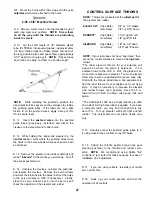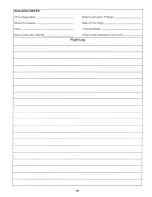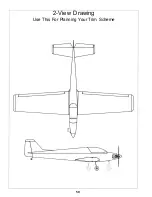
be almost hands off Without touching any other control on the
transmitter suddenly chop the throttle Did the nose drop? When
you add power again, did the nose pitch up a b i t ? It so, you need
some downthrust or nose weight When the thrust is correct the
model should continue along the same flight path f o r at least a
dozen plane lengths before gravity starts to naturally bring it
down
Do each maneuver several times, to make sure that you
are getting a proper diagnosis Often a gust an accidental nudge
on the control's or j u s t a poor maneuver entry can mislead you
the t h r u s t a d j u s t m e n t s are a r e a l pain to make On most models, it
means taking the engine out adding shims then reassembling the
whole thing Don't take shortcuts Don't try to proceed with the
other trim adjustments u n t i l you have the thrust line and/or CG
correct They are the basis upon w h i c h all other trim settings are
made.
Also, while you have landed, take the time to crank the
clevises u n t i l the t r a n s m i t t e r trims are at neutral Don't leave the
airplane so that the transmitter has some odd ball combination of
trim settings One bump of the transmitter and you have lost
everything The trim must he repeatable and the only sure way to
do this is to always start w i t h the transmitter control trims at the
middle
The next maneuver is somewhat more tricky than it
looks To verify the C G , we roll the model up to a 45-degree
hank then take our hands off the controls The model should go a
considerable distance w i t h the f u s e at an e v e n keel if the nose
pitches down, remove some nose weight and the opposite i f the
nose pitches up The trick is to use only the aileron's to get the
model up at a 45-degree bank We almost automatically start
feeding in elevator but that's a no-no Do the bank in both
d i r e c t i o n s j u s t to make sure t h a t you arc getting an accurate
reading of the l o n g i t u d i n a l balance
We now want to test the correct alignment of both sides
of the elevator (even if they aren't split, like a Pattern ship's, they
can still he warped or twisted) Yaw and lateral balance will also
come into play here so be patient and eliminate the v a r i a b l e s one-
by one T h e m a n u v e r is a simple loop but it must be entered
with the wings perfectly l e v e l Position the maneuver so that your
assistant can observe if end-on Always loop into the wind Do
several loops and see if the same symptom persists Note if the
model loses heading on the front or back side of the loop If you
lose if on the w a y up it's probably an aileron problem while a
loss of heading on the way back down is most l i k e l y a rudder
situation
After you get the inside loops going correctly, do the
same maneuver to the outside entering from an inverted position
Before you make too many d r a m a t i c changes glance at the
remainder of the c h a r t and note the many combination of things
we can do just with the ailerons Each change you make will
affect all other variables'
Note that the Yaw test is the same looping sequences.
Here. however we are altering rudder and ailerons instead of the
elevator halves We must repeat that many a i r p l a n e s w i l l not
achieve adequate lateral trim without sealing the hinge gaps shut
The larger you make the loops (to a point), the more discernable
the errors will be
The Lateral Balance test has us pulling those loops very
tightly Actually we p r e f e r the Hammerhead as a better test tor a
heavy wing Pull straight up into a vertical and watch which wing
drops A true v e r t i c a l is hard to do so make sure that your
assistant is observing from another vantage point Note that the
engine torque w i l l a l t e r the vertical f a l l o f f as will rudder errors
Even though w e balanced the w i n g statically before leaving for the
field, we are now trimming it d y n a m i c a l l y
The Aileron Coupling (or rigging) is also tested by doing
Hammerheads This time however we want to observe the side
view of the model Does the plane w a n t to t u c k under a b i t ? I f so.
then try trimming the ailerons down a small bit so that they w i l l
act as flaps It the model tends to want to go over into a loop, then
rig both ailerons up a few t u r n s on the clevises Note that
drooping the ailerons w i l l tend to cancel any washout you have in
the wing On some models the lack of washout can lead to some
nasty characteristics at low speeds
The effects noted w i t h the Aileron Coupling tests can
also be caused by an improperly set wing incidence The better
test for this is knife edge flight I t the model tends to pull
upward, i.e. it swings toward a nose up direction then reduce the
wing incidence I t the model tries to go o f f heading toward the
bottom side of the plane, then increase incidence
Again, we reiterate that all of these controls are
interactive When vou change the wing incidence if w i l l influence
the way the elevator trim is at a given C G Re t r i m m i n g the wing
will also change the r i g g i n g on the ailerons, in effect, and they
may have to be re-adjusted accordingly
The whole process isn't hard As a matter of fact it's
rather fun — but very time consuming It's amazing what you will
learn about why a plane flies the way if does and you'll be a better
pilot tor if One thing w e almost guarantee is that y o u r plane's w i l l
be more reliable and predictable w h e n they are p r o p e r l y trimmed
out They will fly more etticiently and be less prone to doing
radical and surprising things Your contest scores should improve,
too
We wish to a c k n o w l e d g e the Orlando Florida c l u b
newsletter, from which the basics of the chart presented here were
gleaned.
Reprinted in part by Great Planes Model Manufacturing Company,
courtesy ot Scale R/C Modeler magazine. Pat Potega, Editor,
August 1983 issue
See the Flight Trimming Chart on
page 55.
54
Содержание Ultra-Sport 1000
Страница 7: ...7 DIE PATTERNS Use This Drawing To Identify Die Cut Parts...
Страница 57: ...57...
Страница 59: ...2 View Drawing Use This For Planning Your Trim Scheme 59...






































